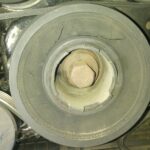Troubleshooting J1939 Data Link issues can be frustrating. This article provides a practical, calculator-based method for accurately diagnosing and resolving these problems, drawing from real-world experience rather than textbook theory. This technique helps pinpoint the root cause of common J1939 data link failures, such as inactive codes for timeouts and communication errors often overlooked by simply clearing codes.
Understanding J1939 Data Link Resistance
Modern trucks rely heavily on the high-speed J1939 data link for communication between electronic modules. This data link typically incorporates two 120-ohm resistors in parallel, resulting in a total resistance of approximately 60 ohms measurable on pins C and D of the 9-pin diagnostic connector. A crucial step in troubleshooting involves understanding how to calculate this resistance accurately.
A standard 9-pin J1939 data link connector.
The basic formula for calculating the total resistance of two resistors in parallel is as follows:
- (R1 x R2) / (R1 + R2) = Total Resistance
Where R1 and R2 represent the resistance values of the individual resistors. With two 120-ohm resistors, the calculation would be:
- (120 x 120) / (120 + 120) = 60 ohms
This simple formula, easily executed with a calculator, becomes a powerful diagnostic tool.
Real-World J1939 Troubleshooting: A Freightliner Columbia Example
While a reading between 50 and 70 ohms might appear acceptable according to some textbooks, experience suggests that even slight deviations can indicate underlying problems. For instance, a Freightliner Columbia frequently exhibiting inactive ABS J1939 timeout codes might show a resistance of 65 to 68 ohms – seemingly within the acceptable range, yet indicative of a potential issue.
Corrosion in a J1939 connector can significantly impact resistance.
To pinpoint the problem:
-
Measure Individual Resistors: Disconnect and measure each resistor individually. For example, you might find readings of 118 ohms and 119 ohms.
-
Calculate Expected Total Resistance: Using the formula, calculate the expected total resistance with the measured values:
- (118 x 119) / (118 + 119) = 59.24 ohms
-
Compare with Actual Measurement: This calculated value (approximately 59 ohms) should closely match the reading obtained on pins C and D of the J1939 connector (allowing for slight variations due to wire resistance). A significant discrepancy indicates a problem.
In the Freightliner Columbia example, a common culprit is corrosion in the 3-way connector housing the resistor near the ABS module. Cleaning this corrosion often restores the resistance to the expected value, resolving the J1939 communication issues.
Applying the Method Across Different Truck Makes
This diagnostic technique applies universally across various truck manufacturers, including Volvo, International ProStar, and other Freightliner models. Practicing on a known-good truck helps establish a baseline understanding of expected resistance values. However, remember that some trucks, like certain Freightliner and International models, require disconnecting the batteries before measuring J1939 resistance due to continuous module communication.
A typical resistor location on a truck frame rail.
Common Resistor Locations:
Knowing where to find these resistors is crucial:
- Freightliner Columbia: Left frame rail, front cab mount (R1); right frame rail near ABS module (R2)
- Freightliner Century Class: Left frame rail, front cab mount (R1); left B-pillar (R2)
- Volvo (Cummins Engine): Near ECM connector (R1); cab fuse panel (R2)
- Volvo (Volvo Engine): Integrated into ECM (R1); cab fuse panel (R2)
- International ProStar: Left frame rail near transmission (R1); on top of transmission towards the rear (R2)
Conclusion
Using a calculator to precisely calculate expected J1939 data link resistance provides a powerful diagnostic tool. This practical approach, grounded in real-world experience, helps technicians accurately identify and resolve data link issues that might otherwise be missed, leading to more effective troubleshooting and reduced downtime. By understanding the underlying principles of resistance calculation and applying this simple method, technicians can significantly improve their diagnostic capabilities and ensure reliable vehicle operation.
